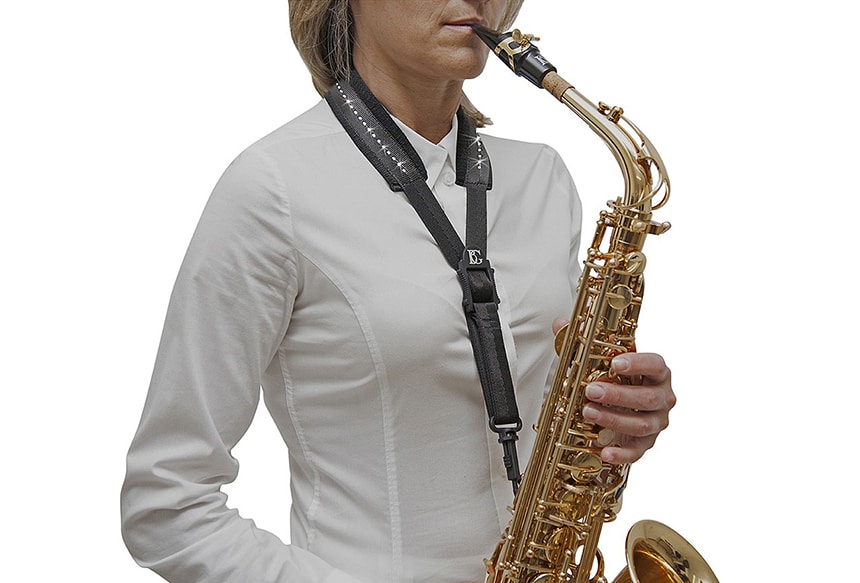Have you ever caught yourself admiring the super-cool sax players on stage? They look so cool and make the whole process of playing an instrument as complex as the sax look easy. However, it is more difficult than it looks. Until you carry your first saxophone and try to play it, you never quite know how to hold a saxophone.
As a beginner, there are several things that you have to learn, and holding the sax is the first thing that you must master. That is why we have provided this post for you. Here, we consider some of the vital steps to holding a saxophone. You will learn all the tricks and tips to holding a saxophone. At the end of this article, you should be able to easily carry this instrument.
As a new player, it is easy to assume that you don’t need the sax strap, after all, all you need is to carry or hold the instrument right. However, there is a reason why even the best sax players still have a strap attached to their instruments.
There are numerous benefits to getting a strap. Apart from helping you to play better, the design of the strap will move the sax’s weight to your body, which will reduce any stress on your neck. Playing with the strap, you will enjoy more stability whether you are standing or sitting.

So, how do you find the right one for you? Well, one way to get the best strap for your instrument is to try different types of straps until you arrive at one that feels comfortable.
There are several types of straps on the market, with all of them featuring different designs. For example, some come with padding, others with harnesses, and still others with hard cords.
When wearing the strap, there are some basic things to check out.
For the strap to be the right fit, you should ensure that the hook of the strap ends up near the middle of your chest. That is why we look for high-quality straps that have a good hook that will completely close and that cannot open with the merest touch. This is an important consideration since you don’t want a strap that will come undone as you are playing.
Apart from getting the right strap, it is also important that after getting it, you know how to attach it to the saxophone.
If you attach it incorrectly, it can cause back and neck pain, which is something you don’t want. One rule of thumb when attaching the strap to the instrument is that the higher the strap, the brighter the sound that you get from the instrument.
So, how can you get the right height? Let’s see.
The first thing to do is to set the strap at different lengths.
Playing those notes with the correct strap attachment will be easier for you. Once that height is set, you will hit sweeter notes with ease. The best position of the strap is one where there are minimal jaw and embouchure movement.
After getting the right placement of the strap, the next thing to do is to get the correct posture. We need to fine-tune as much as we can until we get it right.
Getting the right posture involves keeping certain things in mind. First, the head should be straight and shouldn’t be tilted to any side. Thus, adjust the mouthpiece so that you have even pressure on the two sides of the piece.
If you are using an alto, tenor, or baritone type of sax, keep in mind that these are made to be played from your right. A saxophone stand can help you with posture too.
Here are some practical tips that will help:
In this section, we will highlight the hand position for anyone that is playing the sax.
First of all, your hands should be held in a neutral position right in front of you, and the right hand should be in the same line as the right leg. The same thing goes for the left leg and hand.
Your fingers should be naturally curved, shapes as if you have a softball in your hands. You should hold as if you are shaking another person. For hand positioning, your thumbs should be tucked in and should touch the thumb rests.
In the video below, you can find a detailed explanation of finger positioning and movements.
The alto sax Trusted Source Alto saxophone - Wikipedia The alto saxophone, also referred to as the alto sax or simply the alto, is a member of the saxophone family of woodwind instruments invented by Belgian instrument designer Adolphe Sax in the 1840s, and patented in 1846. It is pitched in E♭, and is smaller than the tenor, but larger than the soprano. en.wikipedia.org is one of the most popular types of saxophone Trusted Source Saxophone - Wikipedia The saxophone is a type of single-reed woodwind instrument with a conical body, usually made of brass. As with all single-reed instruments, sound is produced when a reed on a mouthpiece vibrates to produce a sound wave inside the instrument’s body. en.wikipedia.org and can help you to play different genres of music easily. How can you hold it? Let’s see
The first thing to do is to learn how to play while sitting. This involves getting the right posture. To that end, sit in a straight-back chair and plant your two feet on the floor.
Then, sit straight and ensure that your neck and shoulders are relaxed. Maintaining good posture is important because it makes you play more comfortably and will reduce the chances of injury.
After sitting correctly, pull the neck strap over your head and adjust the length, there should be some tension in the strap as the sax lies on your lap.
The positioning of the hands is the next thing to get. Therefore, make a C with your two hands and ensure that the hands are big enough to wrap around the neck and base of the instrument. Afterward, place the right thumb under the provided lower thumb rest. Then, place the left thumb on the upper thumb rest; this will help the instrument to remain stable while leaving your fingers free to play the other keys.
The next thing when playing the alto sax is to hold it on the right side against the right leg and bring the mouthpiece to your mouth.

The soprano sax is another popular type of sax and there are several similarities in how you hold this type of sax and how you hold the clarinet. Here are the steps needed to hold this type of sax correctly.
First, determine the right position by putting the mouthpiece into your mouth at the tip. If done correctly, the reed of the instrument should face the bottom of your mouth. Reviews show that the Vandoren SR613 is one of the best reeds you can find.
Next, hold the saxophone so that it lies perpendicular to your body, that is, it should face diagonally towards the floor.
After this, use the left hand to hold the top of the sax, with the thumb on the underside to stabilize the instrument and the fingers on the B, A, and G keys.
Lastly, have your right hand on the bottom half of the sax. The right thumb should also be on the thumb rest while the other four fingers cover the apex of the sax.
Before you hold the tenor sax, you need to assemble it. So, the first step is to remove the head of the goose head. Next, clip your neck strap to the strap hole, ensuring that the clip faces upwards to reduce the chances of falling off.
The next step is to get the reed ready by putting it in the mouth. When this is done right, place the reed under the ligature that accompanies the mouthpiece.
Holding the tenor sax is straightforward. First, ensure that the left-hand stays up while the right-hand stays on the bottom. The right thumb will be under the thumb rest while the index, ring, and middle fingers will rest on the pearl keys. The little finger is what moves other keys at the base.
As for your left hand, the thumb should be on the round piece at the top and your other fingers will rest on subsequent pearl keys at the top.
The baritone sax, or the bari, is one of the bigger options to hold, which makes it one of the easier options to hold. The instruments should be held from a strap for even balancing.
To play, you need to sit or stand straight and have the horn hanging naturally by your side. Then you should follow the same steps as in holding the alto sax.
We hope that this article has shown you how to hold a saxophone. Although there are different types, the tips on strap use, posture, and hand positioning should be enough to help you hold this instrument correctly. Happy playing!